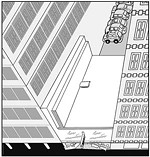Artists as Developers
A symposium gives creative types a new role in rebuilding neighborhoods
By Elizabeth Cobbe, Fri., Sept. 19, 2008
In cities across America, gentrification is both a hot-button issue and a good way to get angry graffiti sprayed all over your construction signs. With population density returning to city centers, low-income neighborhoods with local histories and identities are vanishing under the weight of high-end condominiums. Families find themselves forced to sell homes they fully own as property taxes rise and hard-to-refuse offers from developers begin stacking up.
That's not the entire story, of course. Those low-income neighborhoods often spend decades in decline with high levels of crime and unemployment. Buildings left abandoned become stomping grounds for drug addicts, and local businesses all but disappear. New development makes streets safe again and brings fresh light to a city block.
Real Community Is Real Art: A Texas Workshop on the Arts and Urban Development is a symposium that is intended to address this exact conflict as it plays out in Austin. It begins this Friday, Sept. 19, with a screening of Third Ward TX, a documentary film about Houston's Project Row Houses, a creative redevelopment effort aimed at restoring an existing historic black neighborhood. Saturday's programming includes panel sessions with cultural leaders, activists, and architects, followed by what organizers are calling "community mosh pits," a speed-dating style of putting as many creative heads together as possible in one weekend.
The event is an outgrowth from the filming of Third Ward TX, which received several grants, including one from the city of Austin Cultural Arts Division that required the filmmakers to provide some programming of value to Austin residents. They chose to hold an event with the aim of initiating dialogue on possible alternatives to the usual "resistance approach" to gentrification, in which spray-painted threats and the occasional sabotage are quickly forgotten.
Says Third Ward TX director Andrew Garrison: "If you're not just thinking in terms of the problems you can address, instead, what if we're applying our imaginations to the situation? What can happen? That's what artists do."
"[Gentrification] is coming. You can't stop it," states Third Ward TX producer Nancy Bless. "[Project Row Houses] has a very different approach and attitude toward it."
Spearheaded by Houston artist Rick Lowe, Project Row Houses began in 1993, when a group of artists moved into Houston's Third Ward neighborhood, intending to make a long-term home there. They saw that the neighborhood was a far cry from the mecca of African-American music and culture it had once been in the Thirties and Forties. They began asking residents what they could do to help.
The solutions were practical and maybe not the sort of thing most art students study in school. The houses were falling down, Lowe was told. There was trash everywhere. Could they do something about that?
They did. As part of what ultimately became Project Row Houses, Lowe and a handful of people from Houston's visual-art community showed up every week to renovate a row of abandoned shotgun houses. They cleaned and restored them, and they painted a few murals as they went. As it stands now, Project Row Houses encompasses 22 row houses, public art projects, commercial space, low-income housing, and cultural and community programming. The founding artists continue to live in the neighborhood.
Symposium organizers emphasize that they hope participants will learn from the example of Project Row Houses but not try to copy every detail of the effort.
"We're not going to drive down 11th and 12th streets looking for a row of 20 row houses to rebuild," says workshop producer Ann S. Graham. "That's not going to work here."
East Austin is not the Third Ward, Graham emphasizes. While both neighborhoods were severed from their respective Downtown areas when major highways were built atop the rubble of houses and businesses, East Austin's layout is different. East Austin is more ethnically diverse than the Third Ward, meaning more than one cultural group would have to work together to create community.
As for what Austin-specific solutions are out there, organizers emphasize that the symposium is intended to find – or at least to introduce the people who might discover – new solutions.
"The right hand doesn't always know what the left is doing, and the architecture world doesn't always know what the social-service organizations are doing," says Graham.
Key lessons they have discovered so far are simple. Bless says it's first necessary to get to know a neighborhood and to meet people. "Let the old people talk. Let the people in that community talk. What do they have to say?"
Any successful creative redevelopment must serve the needs of that community, and for that, activists and rebuilders must listen first to the population they want to serve. "It's not just moving in and colonizing like [artists] usually do," Bless adds.
Practical, physical solutions also exist for some situations. Put up lights in dark corners. Build or rebuild houses with front porches to initiate a community presence on the street, where people see one another and what is happening around them.
"You can't think about the problem as 'How can I build a better house?' It's 'How do I retain some of the community space while increasing density?'" says assistant workshop producer Greg Esparza, a recent graduate of the University of Texas School of Architecture.
Other questions remain that, for now, lack good answers. How can a historic community adjust to include low-income and upper-income housing without fracturing? Revitalizing a neighborhood in the way that Project Row Houses has paradoxically invites gentrification that much more quickly. How do artists and activists, whose pockets rarely run as deep as those of developers, hold on to the gains they have made in the face of rising property values, which they have in fact helped to create?
Organizers are hoping for approximately 75 participants in the weekend's events, focusing on local artists and local community builders. Director Garrison says the outreach for the symposium isn't aimed at land developers, even though they're a crucial piece of the puzzle. "I'm not too worried about developers getting these ideas, because if they can develop and make money from it, they'll get it. Show developers that it's profitable. The difference will be made by people already there [in the neighborhoods]. ... It's starting with people who are there, who commit to staying there."












